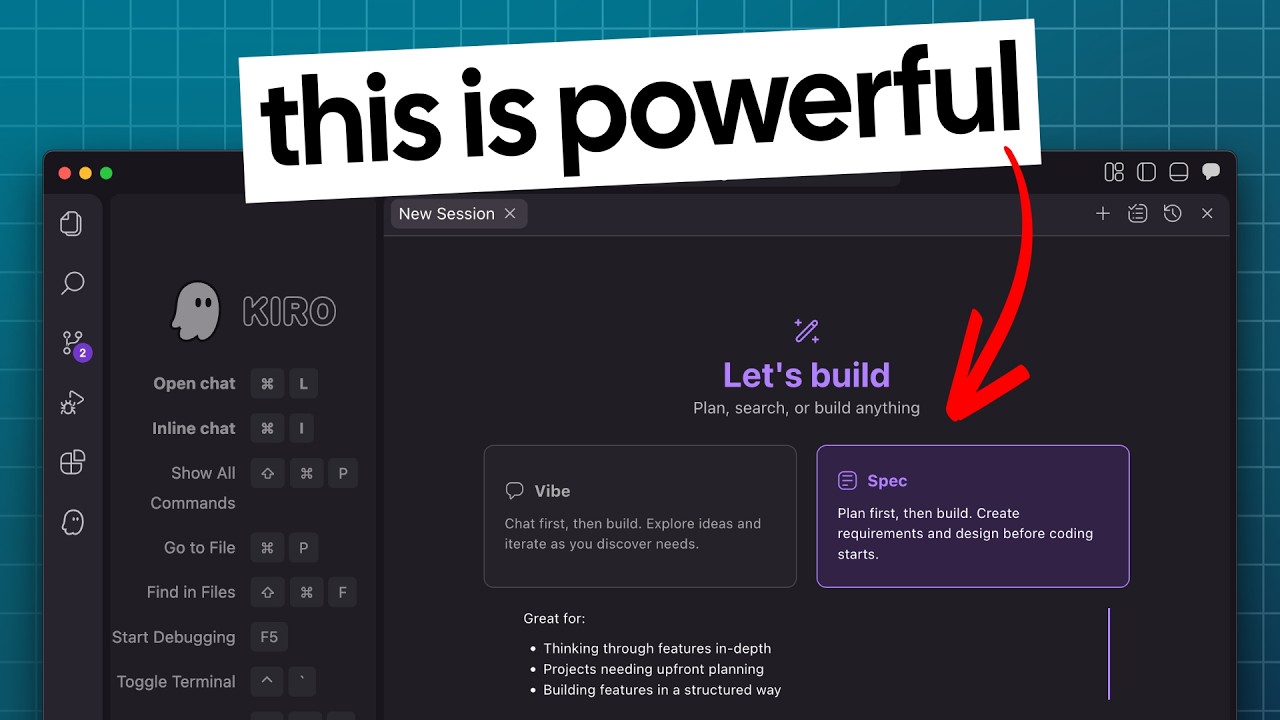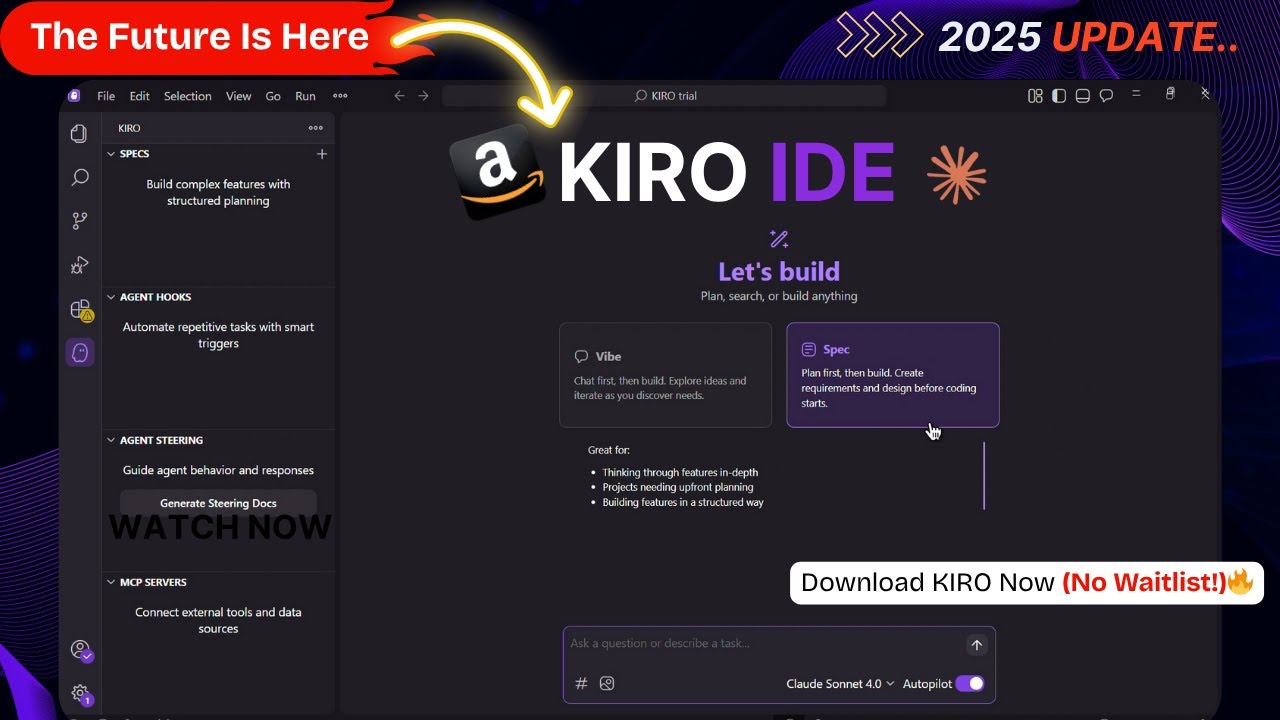AI IDE 评测:Kiro IDE vs VS Code - 规范驱动开发实战测试

初印象:不只是另一个 VS Code 分支
亚马逊的 Kiro AI IDE 凭借其可爱的幽灵吉祥物图标立即脱颖而出——这是对 AI IDE 领域抽象标志的清新突破。但除了吸引人的视觉标识外,这款 AI IDE 还引入了三个突破性功能,使其区别于其他 AI IDE 竞争对手如 Cursor 和 Windsurf。
虽然基于熟悉的 VS Code 基础构建,但这款 AI IDE 通过智能自动化和结构化开发工作流程改变了传统的 VS Code 体验。经过广泛的 AI IDE 实际测试,以下是 Kiro 的独特之处以及相比其他 VS Code 替代品的不足。
入门体验:无缝设置过程
设置 Kiro IDE 非常简单。只需访问 kiro.dev 并下载适合您操作系统的版本。安装过程与其他桌面应用程序类似,欢迎屏幕会引导您完成初始配置。
主要设置功能:
- 强制身份验证:与某些 IDE 不同,Kiro 需要登录(支持 Google 集成)
- VS Code 配置导入:无缝传输现有的 VS Code 设置
- 主题选择:选择您偏好的界面主题
- Shell 命令设置:可选的终端集成,用于命令行访问
这款 AI IDE 界面对 VS Code 用户来说会立即感到熟悉,证实了这款 AI IDE 确实建立在 VS Code 基础上。对于从传统 VS Code 转向 AI IDE 的开发者,Kiro 提供了熟悉的 VS Code 功能与先进 AI IDE 能力之间的完美桥梁。
Kiro 创新的三大支柱
1. 规范驱动开发:代码前先规划
Kiro 最独特的功能是其 Spec 模式,它强制执行"先规划后构建"的方法论。Spec 模式不是直接跳入代码生成,而是引导您完成结构化的开发过程:
需求阶段:Kiro 分析您的提示并生成全面的 requirements.md 文件,确保清晰的项目理解。
设计阶段:AI 创建详细的架构文档,包括系统组件、接口和实现策略。
任务列表创建:结构化的 tasks.md 文件将项目分解为可管理的顺序任务。
实施:只有在完成规划阶段后,Kiro 才开始实际的代码生成,遵循既定的路线图。
2. 智能钩子:响应事件的自动化
智能钩子代表了 Kiro 最创新的功能——基于特定事件自动触发的 AI 代理:
- 文件创建:自动为新文件生成文档或测试
- 文件保存:更新相关文件或运行质量检查
- 文件删除:清理依赖项或更新引用
- 手动触发:按需执行特定任务
这种自动化扩展了您的工作流程能力,允许 AI 处理例行任务,如文档更新、单元测试生成和性能优化,无需手动提示。
3. 增强的 AI 集成
Kiro 专门使用 Claude Sonnet 3.7 和 4.0 模型,利用亚马逊对 Anthropic 的投资。界面提供:
- 自动驾驶模式:允许代理在不请求批准的情况下执行操作
- 上下文管理:轻松添加文档、代码库文件和文件夹
- 图像附件:为复杂需求提供视觉上下文支持
- 聊天历史:全面的交互跟踪
实际测试:身份验证实现
为了评估 Kiro 的能力,我使用 NextAuth.js 测试了其规范驱动开发与实际的 Next.js 身份验证系统。
测试项目
- 基础:全新的 Next.js 15 安装,包含 TypeScript 和 Tailwind
- 目标:实现完整的身份验证,包含登录/登出功能
- 要求:硬编码凭据,受保护的仪表板路由
Spec 模式实战
需求生成:Kiro 成功分析了提示并创建了全面的需求文档,理解了现有项目结构和技术栈。
设计文档:AI 生成了详细的架构计划,包括组件关系和实现策略。
任务分解:系统创建了逻辑性的实现任务序列,从基本设置到最终测试。
实施结果和挑战
初期成功:前四个任务成功完成,Kiro 生成了干净、结构良好的代码,遵循现代开发实践。
关键失败:任务 5 遇到重复的"意外错误"消息,尽管多次重试仍无法完成。
错误模式:聊天历史显示在同一任务上失败了 7-8 次,表明模型限制或 API 限制。
二次测试:主题实现
为了验证 Kiro 的可靠性,我进行了一个更简单的测试:为 Next.js 应用程序添加明暗主题切换。
结果
完全成功:所有任务成功完成,Kiro 在右上角实现了功能性主题切换器。
小问题:徽标在深色模式下消失了,但这代表的是小的样式问题而不是功能失败。
间歇性错误:即使这个更简单的项目也经历了一些意外错误,尽管比身份验证测试少。
智能钩子:承诺与现实
测试智能钩子功能揭示了潜力和当前限制:
设置过程
- 点击幽灵图标访问 Kiro 的侧边栏菜单
- 选择"智能钩子"并点击加号按钮
- 从模板中选择或描述自定义自动化
- 配置触发事件(文件创建、保存、删除、手动)
测试结果
钩子创建:成功创建了文档更新钩子
执行失败:钩子在保存修改的 package.json 文件时正确触发,但以错误结束
监控:系统正确检测到文件更改并启动了 AI 代理
Kiro vs. Cursor:实际比较
经过广泛测试,以下是 Kiro 与其主要竞争对手的比较:
Kiro 的优势
- 结构化规划:规范驱动开发提供卓越的项目组织
- 创新自动化:智能钩子提供独特的工作流程增强可能性
- 免费预览:预览期间目前免费提供
- Claude 集成:访问为代码生成优化的尖端 AI 模型
Cursor 的优势
- 可靠性:更一致的执行,没有意外错误
- 成熟功能:精美的用户体验,粗糙边缘更少
- 经过验证的记录:既定的用户群和社区支持
- 更广泛的模型支持:访问 Claude 之外的多个 AI 模型
当前限制和关注点
技术问题
- 频繁错误:意外失败中断复杂任务
- 模型限制:仅限于 Claude 模型
- 不完整功能:智能钩子显示出前景但缺乏可靠性
工作流程挑战
- 强制身份验证:没有跳过登录要求的选项
- 错误恢复:处理失败任务的选项有限
- 复杂设置:Spec 模式需要比直接编码更多的初始投资
谁应该尝试 Kiro IDE?
理想候选人
- 规划导向的开发者:重视结构化开发方法的人
- 团队领导:需要全面文档和清晰任务分解的项目
- 自动化爱好者:对事件驱动 AI 辅助感兴趣的开发者
- 早期采用者:愿意使用预览阶段软件的人
如果以下情况请考虑替代方案
- 可靠性至关重要:需要一致性能的生产环境
- 需要模型灵活性:需要 Claude 之外特定 AI 模型的项目
- 偏好简单工作流程:直接编码而不需要广泛规划阶段
结论:有前景但尚未准备好投入使用
Kiro IDE 引入了真正创新的概念,可能重塑 AI 辅助开发。规范驱动开发方法解决了 AI 编码工具中的真实问题,促进了更好的规划和文档实践。智能钩子代表了自动化开发工作流程的引人注目的愿景。
然而,当前的可靠性问题阻止了 Kiro 成为专业开发的 Cursor 替代品。频繁的意外错误和不完整的功能实现表明该工具需要更多的开发时间。
建议
如果您对探索结构化 AI 开发的未来感兴趣并能容忍预览阶段的限制,请尝试 Kiro。
如果您需要可靠的 AI 辅助进行生产工作且无法承受工作流程中断,请坚持使用 Cursor。
展望未来
Kiro IDE 的核心概念是合理的,具有潜在的变革性。如果亚马逊能够解决可靠性问题并完成功能实现,Kiro 可能成为 AI IDE 领域的有力竞争者。
免费预览期为探索这些创新功能提供了绝佳机会,无需财务承诺。随着工具的成熟,它很可能实现为 AI 辅助开发带来结构和自动化的承诺。
准备体验结构化 AI 开发的未来了吗?下载 Kiro IDE 并亲自测试其创新的规范驱动开发方法。
相关文章

Kiro IDE 完整教程:精通 Kiro IDE 规范驱动开发与智能钩子
完整的 Kiro IDE 指南,涵盖 Kiro IDE 革命性的规范驱动开发工作流程、Kiro IDE 智能钩子自动化,以及 Kiro IDE 如何改变编码实践。

AWS Kiro IDE vs Cursor:亚马逊AI开发环境完整对比评测
深度对比 AWS Kiro IDE 与 Cursor,了解亚马逊 Kiro IDE 如何通过 Claude AI 集成和创新功能挑战 Cursor 在AI开发领域的地位。

Kiro IDE 下载安装教程 2025:Windows、Mac、Linux 完整安装指南
详细的 Kiro IDE 下载安装教程,支持 Windows、Mac 和 Linux 系统。几分钟内开始使用亚马逊的 AI 驱动开发环境。